You get exactly what you see in the title and subtitle of this latest book examining the Marine Corps’ often-overlooked, innovative Combined Action Platoons counterinsurgency program. Ted Easterling, a retired university history professor who served as an enlisted Marine combat engineer during his 1966-67 Vietnam tour, offers a concise, well-documented and chronological look at how the concept was applied starting in 1965, how it peaked in 1969 and the way it ended in 1971 when the last CAP unit was deactivated.
The book, based on Easterling’s doctoral dissertation, includes an in-depth analysis of the CAP strategy’s strengths and weaknesses as one of the U.S. programs established to win the “hearts and minds” of the Vietnamese population. Easterling describes how the effort played out on the ground and how it fit with the overall U.S. military strategy. He details the CAP units’ attempts to provide Vietnamese villagers with assistance to encourage support for South Vietnam’s government and deny aid to the enemy. The Marines worked on civic action projects such as building schools and providing medical care, while also defending the villages militarily.
Easterling agrees with British military historian David Strachan-Morris in his recently published book on the CAPs, Spreading Inkblots: From Da Nang to the DMZ, that the program generally worked well—but wasn’t implemented widely enough to influence the war’s outcome. The CAPs were allowed to do their work only “on a limited scale,” Easterling writes. “The opportunity to use this successful counterinsurgency method more widely was squandered.”
The CAP program’s success was also limited by actions of the South Vietnamese government, which did not offer villagers an inviting alternative to the Viet Cong and North Vietnamese. As Easterling puts it: “It was difficult for the CAP program to convince the Vietnamese people that they should be loyal to the central government when [it] was corrupt and unresponsive to many of the people’s needs.” Widespread corruption, he continues, “put the Marine Corps in the difficult position of trying to gain the loyalty for a government which did not deserve that loyalty.”
Additionally, the South Vietnamese military wasn’t much help when it came to winning hearts and gy and tactics. Agreeing with most Vietnam War historians who have analyzed the problems with CAP, Easterling puts the lion’s share of the blame on the shoulders of Gen. William Westmoreland, the top U.S. commander as head of Military Assistance Command, Vietnam. He argues that Westmoreland merely gave lip service to the CAP program while stubbornly waging a war of attrition using search-and-destroy tactics.
Westmoreland consistently shunted aside advice from leading Marine generals, primarily Lt. Gen. Victor “Brute” Krulak and Marine Commandant Gen. Wallace Greene, who strongly advocated for widespread use of the CAP program. “In this conflict of opinions and practice,” Easterling says, “the CAP program was often caught in the middle.”
Army Gen. Creighton Abrams, who succeeded Westmoreland in 1968, initially expressed support for the CAP idea, but the program was phased out in the beginning of 1969 with the advent of the Nixon administration’s Vietnamization policy—the gradual shift of responsibility for combat operations from U.S. forces to the South Vietnamese.
In War in the Villages, Easterling makes a good case that the failure to implement the CAP program more extensively was one of the biggest American mistakes in the Vietnam War.
This post contains affiliate links. If you buy something through our site, we might earn a commission.
This article appeared in the October 2021 issue of Vietnam magazine. For more stories from Vietnam magazine, subscribe and visit us on Facebook:





